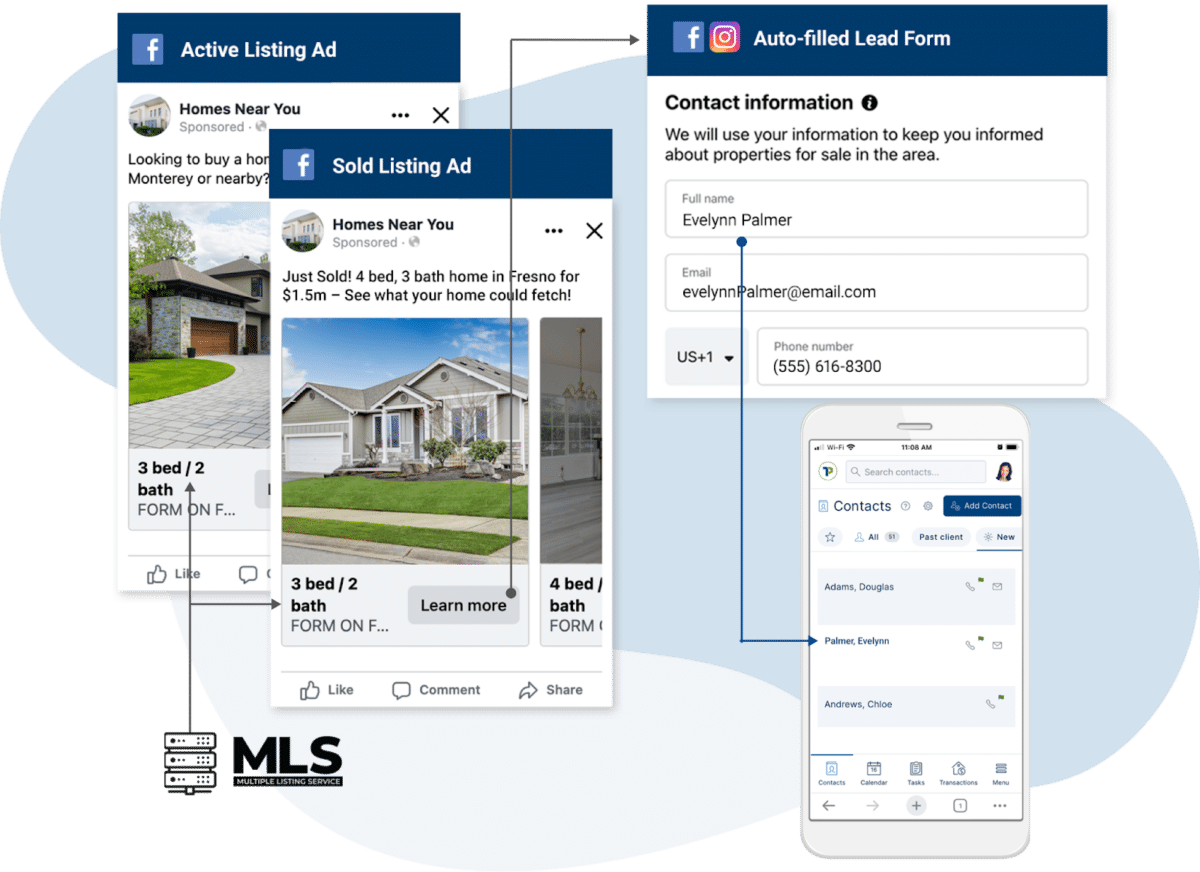Real estate prospecting is the act of generating new clients through active outreach and outbound communication. Rather than waiting for the phone to ring, a real estate agent engaged in prospecting picks up the phone (or emails or texts or knocks on the door) to initiate contact with potential clients.
Learning how to prospect in real estate can be one of the most rewarding pursuits, and, undoubtedly, it’s the best way to generate new leads. If you need to level up your real estate prospecting, I compiled this list of my 15 best tips and have a resource to help you get started right away.
However, before you jump right in, take a look at Sold.com. It’s a referral service that matches sellers and buyers with agents in their area—and best of all, it’s completely free. So while you’re out there prospecting, Sold.com is busy generating leads.
1. Learn the Art (& Science) of Real Estate Prospecting Letters
A critical tool in a real estate professional’s toolkit is the prospecting letter—especially handwritten ones. Simple, efficient, and inexpensive, a prospecting letter serves several purposes:
Make sure your prospecting letters are personalized, professional, and authentic. Your goal is to demonstrate your value and prompt prospects to reach out, so include a motivational call to action.
Get started today: Write a prospecting letter to 10 neighboring homeowners about the last transaction you were involved in. Share exactly what you did to complete the job and how you’re ready to help the recipients sell their homes. We’ve got you covered here with our best letter templates and how to use them!
The Close resource: The 15 Best Real Estate Prospecting Letter Templates for 2023
2. Try Circle Prospecting
Circle prospecting is all about reaching out to the 30 (or so) homeowners who live close to your latest listing or recent closing. Let them know real estate activity is happening in the area and that it is an opportunity for them to get in on the action.
I use a one-two-punch strategy for circle prospecting:
- The moment a listing goes live (or a sale closes), send a postcard or letter alerting your community to the activity.
- Follow up with a phone call (or, if you’re feeling bold, a door knock) the day after to start the conversation.
Get started today: Look through your listings (or recent sales), pick a neighborhood to focus on, and send out 30 cards (ideally handwritten). Make sure you’re recording all of this activity in your customer relationship manager (CRM) so you can track your results and add any interested prospects to text or email drip campaigns.
The Close resource: How Circle Prospecting Got One Tampa Realtor 200 Leads in ONE DAY
3. Base Your Real Estate Prospecting on Predictive Analytics Data
Realtors who use data to guide their decision-making processes are going to come out ahead when prospecting in real estate. Track what you’re doing, what’s working, your response rates—and especially who you’re targeting—so you’re not spinning your wheels.
You can also use data developed through predictive analytics. Say you want to send prospecting letters but don’t want to waste money on those who aren’t interested. Predictive analytics companies such as SmartZip use thousands of data points to narrow down the prospects in your community most likely to buy or sell.
Get started today: Put big data to work for you in your prospecting. Check out how a predictive analytics platform like SmartZip or Offrs can help you narrow down the prospects in your community to only those most likely to buy or sell. Check out our deep-dive reviews on some of our favorite predictive analytics companies.
The Close resource: SmartZip Deep Dive Review; Offrs Deep Dive Review
4. Get Some Face Time With Real Estate Prospects
Let’s start by establishing your overall goal for prospecting. Yes, you want listings and closings, but prospecting is also about establishing the first step in your relationship with a lead. Finishing up a cold call with a listing in your pocket is rare. It’s much more common that you set a date for an in-person meeting.
My first broker, who’d been in the business for decades, used to say he would prospect in hopes of a handshake. He’d offer to take a stranger to coffee, drop by to see an FSBO listing—anything to get in front of a buyer or seller and establish a connection.
Humans crave connection on a deep level and the trust that comes with it. A solid relationship with a client increases your chances of closing a deal, which all starts with a handshake.
Get started today: Set up office hours at a local coffee shop. Every time you speak to a cold-outreach prospect, mention that you’re going to be at a coffee shop on a particular morning, and they should drop by for a cup of coffee (on you) to talk real estate (or fly fishing or animal rescue, or whatever is going to start building that relationship). Creating a non-confrontational way to offer a face-to-face experience is an excellent way to build relationships.
The Close resource: If you’re nervous about breaking the ice with strangers while prospecting, here’s our list of the most outrageous, unbelievable real estate facts to warm the conversation up and get things moving along.
5. Remember, You’re Providing Value to Your Community
I often hear new agents say they don’t want to bother anyone with cold calls or door-knocking. Yet the reality is you’re providing value to your community.
When you reach out to potential buyers and sellers, letting them know about your services and expertise, you also make them aware of their real estate options. Remember, you’re the professional. You’ve received specialized training to help your clients make the best real estate decisions possible.
Have confidence in your contribution to the community and be the expert who helps clients navigate buying and selling.
6. Make Your Weekly Goals About Work & Your Long-term Goals About Results
Prospecting is hard work, and it’s easy to feel like you’re spinning your wheels if you don’t set benchmarks. Make your weekly prospecting goals about your work (the number of calls you make, the number of texts you send, the number of doors you knock on). Center your quarterly goals around the amount of business you close.
This high-level thinking will keep you motivated and focused on big-picture targets—not minor setbacks.
Get started today: Prospecting should be a part of your overall lead generation strategy. Consider where you need to apply your efforts and resources to stay focused on reaching your long-term goals. Use our lead generation plan template to create your blueprint.
The Close resource: 37 Underrated Real Estate Lead Generation Ideas
7. Use an Autodialer to Improve Your Efficiency
Cold calling is not for everyone. In fact, it can be pretty challenging, especially if you hate to hear “no.” But agents cold call because it works. Research shows that if you’re consistent and put in the time, you will generate leads.
If you’re a cold caller, you need the best tools available. I like REDX, which provides leads—expired listings, FSBOs, targeted neighborhoods, and preforeclosures—for you in an organized customer relationship manager (CRM). Their power dialers, which can make you much more efficient, keep the phone calls ringing—all you need to do is polish your scripts.
Get started today: A good first step is to check out our complete guide to real estate cold calling.
The Close resource: Next, you’ll want to decide if a product like REDX, Mojo Dialer, or Vulcan7 can help you level up your cold-calling game. When you’re ready to boost your productivity and prospecting efficiency, REDX offers to waive its $150 setup price for The Close readers.
8. Create a Lead-generating Website
Real estate prospecting is easier if people are already familiar with who you are and what you do. If you haven’t already, create a professional website that provides visitors with information about selling a home in your community. Additionally, offer your visitors an opportunity to search for properties currently listed for sale and a way to contact you with questions.
The very best site providers include lead generation services, which means they capture information from people perusing your site so that you can reach out to them. Website lead gen works because you’ll have easier conversations and higher conversion rates when you speak to your prospects directly.
Get started today: There are a lot—and I mean a lot—of options when it comes to website builders. Start by checking out our roundup of ourtop picks for website builders.
9. Engage on Social Media
As mentioned above, prospecting isn’t about cold calling and mass mailings. It’s about starting (and cultivating) relationships with people you think will be buyers or sellers. I’m sure you often hear how important it is to market yourself and engage on social media. So, what does that actually mean in practice?
Post regularly to your social media platform of choice (I recommend you pick two networks to focus on), but also comment on and like the posts of your followers and those you’re following. Use real estate hashtags to connect with new buyers and sellers. Be part of a larger conversation in your community.
In addition, use social media to connect to people who share your interests. My favorite example is a friend of mine who’s a history nerd and agent. He actively posts and comments on our community history pages so buyers and sellers see him as an authority on the local area. He’s so well-known and respected that he has a huge advantage when prospecting for leads.

Grow your database with a steady stream of affordable, exclusive real estate leads from social media ads. Social Connect from Top Producer is designed to get you a high volume of leads and move them through your pipeline until they’re ready to buy and sell real estate. Connect with an average of 30 consumers interested in real estate in your local market for just $300 per month!
How Social Connect works:
Get started today: Use your social media accounts to connect to others with similar interests and parlay those online interactions into real-life ones.
The Close resource: Check out our library of social media tips and strategy guides and our collection of proven real estate marketing techniques that generate leads.
10. Dedicate 90 Minutes Each Day to Prospecting
Your real estate prospecting efforts will only be successful if they are consistent. Prospecting is a lot of work, so thinking you will get it done in a couple of minutes daily isn’t realistic.
Successful real estate agents set aside 90 minutes every day for prospecting. If you can commit to a regular schedule, you’ll be amazed at the results that 7.5 hours of prospecting each week will yield.
Get started today: Head to your calendar and block off 90 minutes of protected time to prospect each day. I suggest making it the first thing you do every morning since you’re more likely to use your CRM in the morning anyway.
The Close resource: Not in love with your CRM? Check out our round-up of top CRMs and see if one is a better fit for you and your prospecting activities.
11. Call Expired Listings. Every. Single. Day.
Expired listings represent a golden opportunity to land real estate seller leads. After all, these owners have raised their hands and said, “I want to sell my home!” For one reason or another, their home hasn’t sold yet. But chances are, they still want a buyer.
Before you get an owner of an expired listing on the phone, prepare background information on their property. How much was it listed for? Was it priced right? Was it marketed correctly? Has it been listed more than once in recent years? Use effective expired listing scripts to overcome objections and move quickly.
According to Vulcan7, almost 40% of expired listing homeowners relist within 30 days, which means you have an excellent chance of being their new agent and closing a deal. But also, you’re not the only agent prospecting these leads, so the sooner you get on the phone and start making connections, the better.
Get started today: Head to your MLS and set up an alert for any property that changes to “expired” status.
The Close resource: The 26 Best Expired Listing Scripts + Objection Handlers
12. Call FSBO Sellers. Every. Single. Day.
Like expired listing sellers, FSBOs are fantastic prospects because they have publicly announced that they want to sell their homes.
However, your strategy will differ from expired listings because FSBOs believe they don’t need a real estate agent (or at least they claim to). Either that, or they don’t want to pay a commission. Often, all it takes to win these listings is a savvy pitch and persistent follow-up. Call attention to the fact that homes sold by a Realtor tend to sell for 32% more than FSBO homes. That percentage could more than account for any concerns about the commission.
Get started today: Be sure to set up a new listing alert for FSBO homes on Zillow since more than 90% of FSBO homes are listed there.
The Close resource: Get comfortable with our best FSBO scripts and assemble a generic FSBO deck that you can tailor to individual homeowners.
13. Don’t Fear the Word ‘No’
According to a famous study by Baylor University on real estate cold calling, it takes an average of 209 calls to set one appointment or get a referral. For those of you who fear rejection, the takeaway is that you will have to endure a lot of gut-wrenching “no’s” before you finally get a “yes.”
For those who have already overcome your fear of “no,” this statement is music to your ears. It means that for every “no” you get, you are quantifiably closer to a “yes.” It means that you will get three appointments if you can make 627 calls weekly (which is totally doable in your 90 minutes each day).
Get started today: Practice with our cold calling scripts. Practice, practice, and practice some more until it’s rote. Practice with family, friends, and fellow agents who can throw objections at you. If your scripts flow naturally, you’re not going to be bothered by a “no”—you’ll just be on to the next potential prospect.
The Close resource: How to Overcome the 3 Most Common Seller Real Estate Objections Like a Boss
The 33 Best Real Estate Text Message Scripts for Agents
14. Send Direct Mail (It’s Still King)
We know it might not be cool, but plenty of people out there (especially older generations, the ones who actually have houses to sell) appreciate direct mail. Whether it’s a postcard, a thoughtful handwritten letter, or a timely market report, put a stamp on it. The Close’s own Trevor Jones says you get bonus points if you time your voicemail drops to coincide with the arrival of your mail—you get double the impact!
Get started today: Use that data from your predictive analytics resource to ensure you’re targeting the right audience and plan your direct mail cadence.
The Close resource: Check out our round-up of favorite postcards, learn how to use them to generate leads, and get our free design guide.
15. Nurture Your Prospects
🚨Friends, real estate agents, I can’t say this enough: You can prospect all you want: write letters, cold call, talk to everyone in line at the grocery store, but if you don’t nurture your prospects, they won’t ever turn into leads. OK, lecture over.🚨
How do you do it successfully? Start with our guide on long-term lead nurturing, where we offer plenty of tips and tricks to ensure your prospects aren’t falling through the cracks.
If you have a great CRM, it should come with automation that will help you maintain contact with your prospects. Generally, it takes dozens of “touches” for a prospect to become a lead, and a CRM’s automated email and SMS drips can do just that.
At its heart, though, nurturing is really about showing people that you actually care about them and are paying attention to their needs. Remember birthdays, anniversaries, favorite sports teams, and kids’ names (or use your CRM to help you remember), and you’re halfway there.
Get started today: Think of 20 people in your sphere of influence (SOI) or recent prospects and reach out. Send an email or text (or social media DM) to check in, say you’re thinking about them, celebrate a recent birthday, see how back-to-school went, ask how they spent a recent holiday, or reference a good-natured sports rivalry. We bet you hear back and can move those prospects into your leads column.
The Close resource: Lead Nurturing: Tools & Strategies for Conversion (+ Scripts)
Bringing It All Together
So, then, what is prospecting in real estate? Real estate prospecting is never forgetting that you’re providing a service to your community through your expertise and professionalism and letting your community know just that! Prospecting in real estate can be tough, but it works. If you put in the time, remain consistent, track your progress, engage with your community, and have some helpful scripts handy, you’ll be successful. On those hard days, remember that each “no” is getting you closer to the “yes.”
Have additional questions or tips for your fellow agents? Leave us a comment below!









